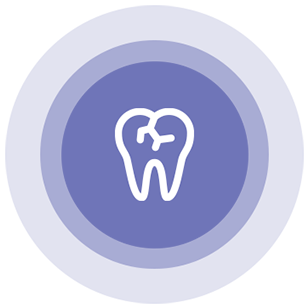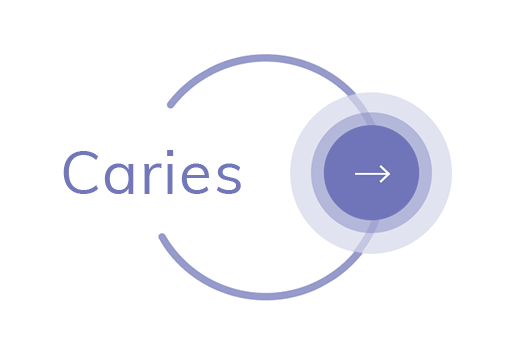Dental Caries
Multifactorial disease
Dental caries is a multifactorial disease that involves an interaction between teeth, saliva and oral microbiota, as the individual’s own risk factors, and diet and oral hygiene, as the main external factors. The infection begins with the accumulation on the enamel surface of specific bacteria, which produce acidic by-products that demineralise and destroy the tooth. If the process is not stopped, the tooth can be totally destroyed.
Multifactorial disease
Dental caries is a multifactorial disease that involves an interaction between teeth, saliva and oral microbiota, as the individual’s own risk factors, and diet and oral hygiene, as the main external factors. The infection begins with the accumulation on the enamel surface of specific bacteria, which produce acidic by-products that demineralise and destroy the tooth. If the process is not stopped, the tooth can be totally destroyed.

One of the most common oral diseases
Traditionally, Streptococcus mutans has been considered to be the main microorganism responsible for dental caries.
Other microorganisms are also involved, such as Lactobacillus, Actinomyces and other types of Streptococcus, but their role is less important.

- Consumption of high-sugar foods and beverages
- Eating between meals
- A diet high in fermentable carbohydrates
- Deficient oral techniques: such as a lack of toothbrushing, the use of ineffective toothpastes or not using dental floss or interproximal brushes
- The decrease in pH of saliva
- Long periods between meals and brushing. The longer the period, the greater the chances of bacteria attacking and acid affecting teeth.
- Inherited genetic susceptibility.
- Some drugs alter the composition of the oral biofilm and the pH of the mouth, so that those who ingest them are more susceptible to caries. In addition, sugar is the major component of antacid pills and cough syrups and drops, products often taken by children. Sweetened medications can be particularly problematic for those who suffer from chronic diseases and follow long-term therapies.
- In the case of younger children, sleeping with a bottle of sugary liquids can also promote its onset.
- Age, overall health, fluorides, educational level, socioeconomic level and a history of caries

The most common diagnostic techniques are based on the analysis of the following aspects:
- History and nature of pain:
circumstances surrounding its manifestation, duration and type of sensation experienced by the patient. - Reaction to thermal changes:
carried out in the dental office by placing a cold or very hot object on the tooth. - Reaction to electrical stimulation:
done with a low voltage direct current. This test evaluates the degree of inflamed pulp nerve excitability. - Tooth’s reaction to percussion:
a positive reaction to percussion indicates that there is inflammation of the apical periodontal tissue (supporting tissue around the end of the root of a particular tooth).
- Radiographic examination:
used to determine the extent of the caries lesion and to determine if the inflammatory response has reached the periapical tissue. - Visual exploration:
used to determine the location and extent of lesions. - Palpation of surrounding area:
if palpation of the periapical area causes pain, it means that the inflammation has reached the tissue surrounding the apex of the tooth.

Solutions
-
Preventive measures include:
In-office topical fluorides
Home application fluorides
-
Other possible preventive measures include the use of:
Chlorhexidine: has shown to be effective in reducing the appearance of carious lesions in high-risk patients.
Pit and fissure sealants: preventive measure for both adults and children.
Xylitol: Xylitol is a potent non-caloric, natural sweetener that is not accepted as a source of nutrients by cariogenic bacteria, thanks to its five-carbon chemical structure that cannot be recognised by Streptococcus mutans. It is capable of reducing the rate of bacterial plaque formation, increases salivary flow and stimulates remineralisation.